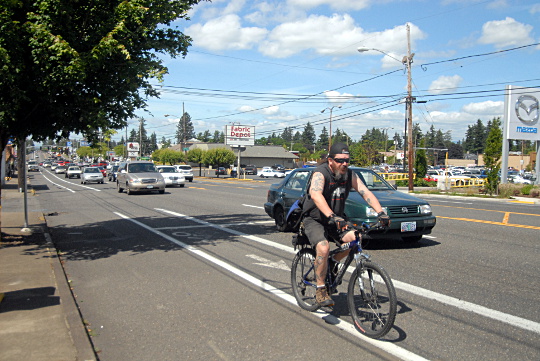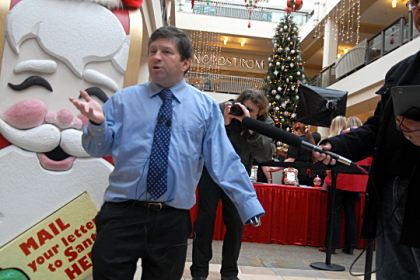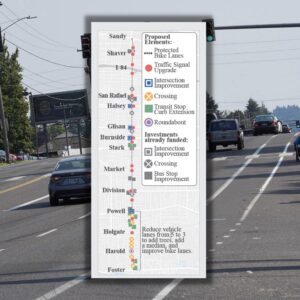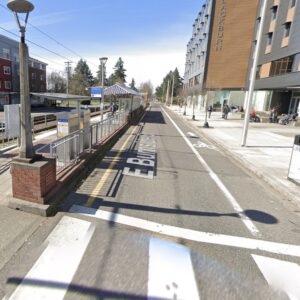East Portland’s most important north-south street is about to get much easier to cross on bike or foot, and also its own frequent-service bus line.
TriMet is preparing to improve its No. 71 bus to run every 15 minutes or better almost all day, every day, between Parkrose and Lents, transit agency spokeswoman Mary Fetsch said this week. It’ll happen after an $8 million City of Portland investment in 122nd Avenue pavement, sidewalks and crosswalks that’s expected some time in the next year.
TriMet requested those street improvements as part of an informal understanding with the city about what it’d take to improve the bus line.
The 71 will become TriMet’s 13th frequent service bus line, and the first new one to be created in 10 years. It’ll be one of only four that doesn’t connect to downtown Portland; the other three are the 72 (which is also TriMet’s most-boarded bus line), the 75 and the 57.
“Once the City has made these high-priority safety and access improvements, we will improve the 122nd Ave service to Frequent Service on Line 71 between Parkrose and Lents as soon as possible,” Fetsch wrote in an email. “We have not entered into an [intergovernmental agreement] yet, but expect to as this moves forward.”
The No. 71 bus is already very popular on the street, even with its current 20-minute frequency for most of the day. (On Sunday, frequency currently falls to 25 minutes.) As of 2011 a single stop on the line, at 122nd and Burnside, drew more riders than the entire 96-block length of the No. 25 bus line on east Glisan Street. TriMet is not planning to improve frequency on the section of the 71 that runs further west, between Parkrose and Clackamas Town Center.
TriMet’s statement marks a significant victory for Portland Transportation Commissioner Steve Novick, who has talked frequently about the need for 122nd to have a better north-south bus line to connect to other major east-west routes.
“We’re super excited about 122nd,” Novick transportation policy advisor Timur Ender said Wednesday. “Novick has been talking about increasing service on 122nd ever since he started at City Hall.”
Advertisement
A frequent bus line on 122nd was on Novick’s 2013 letter to Santa Claus, when he started promoting a new Portland Street Fund. Last year, it became a key part of the city’s Street Fund pitch to voters: city leaders cited TriMet predictions that if the street’s sidewalks and crosswalks could be fixed up, the transit agency would increase frequency on the 71.
Now, thanks to Portland’s big budget surplus, the city has found the money to do the projects some time in the next year without a new street fund. It’ll cost $8 million from the city’s general fund: $4.7 million for various sidewalks and crossings between Parkrose and Foster Road, $3.3 million for a major repave between NE Skidmore and NE Siskiyou streets.
TriMet’s tax revenue, too, has rebounded thanks to growth in Portland-area payrolls.
Some nearby side streets will get fixes too, city transportation spokesman Dylan Rivera said.
“Maybe there’s a sidewalk gap, a way that people need to access 122nd or get to a destination from a TriMet stop on 122nd,” Rivera said. “We’re viewing it as a corridor.”
Rivera said the city has yet to settle on designs for the new crossings, including decisions on whether they’ll include curb extensions (which would shorten crossing distances, but could complicate any future plans for a protected bike lane on 122nd).
“There’s a lot of details and decisions to work out,” he said.
Correction 1:20 a.m.: An earlier version of this post neglected to mention the 75.








Thanks for reading.
BikePortland has served this community with independent community journalism since 2005. We rely on subscriptions from readers like you to survive. Your financial support is vital in keeping this valuable resource alive and well.
Please subscribe today to strengthen and expand our work.
Excellent!
Nice work, Mayor Hales and Commissioner Novick!
I try and avoid these main streets…not much for breathing all the car and trimet fumes…would like to see and non-main street be a bike blvd a few blocks on either side of 122nd…
You would have to demolish houses, because most of the streets do not go through.
122nd is it. There is nothing even remotely contiguous like that around it. Even with an unlimited budget you’d be stretching past the bounds of eminent domain.
‘Nothing remotely contiguous’. Like the 110’s or 130’s bikeways in the 2030 plan? They’re not straight line paths, but they reach almost all the distance from I-84 to Foster.
We should make this a streetcar improvement connecting to Gateway and the MAX. That way, Gateway can become another downtown with density. Also, a road diet with protected lanes would separate riders from direct fumes on 122. Further, the streetcar would spur development along 122 and all the many, many, many big box stores and parking lots. I’m not talking about removing the grocery stores or other stores, either. We could reappropriate the developments to make more sense and have retail on 122 facing the streetcar with mid to high rise density above it.
Here’s an easy formula for that: add a zero to the budget, multiply by 3, wait 7 years for federal approval, an viola! Streetcar!
Then we should be actively lobbying for it now, even after rapid bus. It’s obvious this stretch needs fixed transit to spur 20-minute hoods.
There are some bike routes on the minor streets out there. You have to turn a lot, sometimes hard to cross arterials, or at least a long delay, and signage is poor – better signs directing bikes would be a cheap way to make them more usable.
Most of the bikeways east of I-205 have not been built yet. the 130’s project is closest to being initiated.
I’m not sure I understand why curb extensions have to complicate plans for a future protected bike lane. Don’t those new Dutch or safe intersections make all that work? Pedestrian leaves main sidewalk, steps across bike lane, waits on the curb extension for bus or crosswalk…is that still a pipe dream? Seems like there’d be plenty of room for both on 122nd, and I’d like to think someone’s at least considering it.
Could complicate plans if built one way; wouldn’t necessarily complicate plans if built a different way.
The island of that design is where the bike lane of today is.
I vote to eliminate on-street parking on 122nd and change the bike lane into a delineated buffer with bikes riding the in the former bike lane. In the future we can change the delineated buffer into raised curb, or raise up the whole space.
It will be interesting. We will still have buses going from the curb across the bike lane to the middle lane and back again everywhere the driver feels like it. Option is to eliminate parking on both side of the street and let the buses take the curb lane for the duration. Still have to let the right turn drivers cross the bike lane.
That’s actually a great idea. Traffic can really back up on that street, so a BRT style lane would really speed up the bus line. Cyclists would gain space because dooring would no longer be an issue.
There is such a surplus of parking-lot parking in that area that the street parking (at least on main streets) is rarely used. That would provide a lot of space for buffered or separated bike lanes, pull bikes slightly away from tailpipes, and really improve riding (assuming pedestrian bump-outs can be addressed). The problem with leaving the main streets in this part of town is the lack of alternative side streets. It takes a map or intimate knowledge of the streets (and often some gravel riding) to make your own alternative route. Then you’re dropped at horrible crossings (5 lanes of Division at 45 mph) and your north/south alternative streets don’t line up, so you’re still riding on busy arterials, with no supporting infrastructure as you wind your way east and west to go north or south. It’s not impossible, it’s just difficult and unpleasant.
Let the bus stop in the right lane and add a boarding island in the bike lane, with bikes using former parking lane as bike lane.
http://nacto.org/cities-for-cycling/design-guide/cycle-tracks/one-way-protected-cycle-tracks/
I hope they won’t stop the frequent service all day at parkrose, the parkrose to clackamas through foster powell part of the route is also pretty important and stops running far too early currently.
Line 75 is frequent service and doesn’t pass through downtown, so there are three existing frequent service lines.
Right you are! Fixed.
There should be enough funding, assuming parking is eliminated , to include buffered bike lanes part of this project. There is no reason not to as this has local support (I recently checked) and it is desperately needed route.
Sounds like something BikeLoudPDX should make some noise about.
I will bring up what I know at July’s meeting. 😉
>assuming parking is eliminated
This is why I’m skeptical.
I wouldn’t be too sceptical, I ride out there well – maybe not frequently, but often. In my experiences no one parks on the street there anyway. Those that usually do are centered around the apartment buildings. Most the commercial businesses have more than sufficient parking lots for their customers.
Fully protected bike lanes would be far better than buffered.
And over 10X the cost.
Depends on what the lane ends up being protected by, doesn’t it? Movable planters, for instance – can those be ten times the cost of paint?
Are there any plans for a protected bike being considered? It’s hard to think of a street where it would be easier to implement or where it would come with more benefits. Cycling in the existing bike lanes can be somewhat scary, but there almost entirely unused parking. The parking could become the bike lane and the bike could be converted into floating bus stops, planters and crossing islands. It would have almost no downside for those driving, but would be a massive improvement for those cycling, walking or riding the bus.
*protected bike lane
**there is almost entirely unused parking beside them
***and the bike lane
I’m embarrassed by the number of errors in that post. Any chance we’ll ever get the ability to edit our posts for a couple minutes after submitting?
I second the protected bike lane, and wish this were a streetcar improvement! Not frequent bus. They need to make a circulator to Gateway to connect to a new polycentric downtown area there.
in the medium-term, a buffered bike lane allocates space for more improvement later.
Right? Why does a 5 lane road surrounded by parking lots need on-street parking? There is so much room for protected cycle tracks and it would be negligent of the city not to install them.
The budget for this is $8 million and thus far none of it is targeted towards bike facilities. Do you really think demanding protected bike lanes from this pot of money is going to be helpful?
I should also note that asurvey in Portland suggests that buffered bike lanes greatly improve perceived comfort and correlate with increased bike traffic.
According to the survey data, the number of cyclists choosing to ride on these streets is significantly higher than before the buffered bike lanes were installed. Nearly 65% of the respondents indicated they choose to ride on the buffered bike lanes more often.
Cyclists indicated that they are choosing to ride on SW Oak and SW Stark more often than before the buffered bike lanes were installed. They overwhelmingly agree that the streets are safer, easier and contribute to a better cycling environment in Portland.
http://bikeportland.org/wp-content/uploads/2011/02/PSUCycleTrackBBLReportFINAL.pdf
Yes I do, and considering this is a bike blog, why is that an unreasonable request to make here? Decent protected bike lanes can be constructed for under $30K per mile, and at 5.6 miles from Sandy to Foster, that comes to $168K, or 2.1% of the total budget of $8M.
I challenge the idea that one can build a “decent” protected bike lane for $30,000 a mile (and I don’t consider blog post is not evidence). I should note that my preference on 122nd would be for a curb-protected bike lane.
This is great news, but the first two sentences are misleading, and arguably wrong. 122nd is important, but 82nd, aka Highway 217 is the proverbial Maginot Line of the PDX that has/has not. If we want real change in East Portland, City Hall needs to tackle the hard job and figure out what it will take to get ODOT to merge 217 with 205, so PDX can continue to grow.
And when I say City Hall needs to tackle the job, I mean they need to push through the tax increases it will take to pay for that. And voters need to recognize they can’t keep disenfranchising almost a third of PDX.
Or we can listen to complaints about how rent in Portland is too high, when everyone is only talking about 2/3rds of Portland, for the next 10 years.
Renters are actually 40% of residents in Portland, not a third, even though I suspect you mean land area. The ones being disproportionately affected are renters. And most people who are anti-tax are land/property speculators who are fine with the status quo. Shortage drives up prices for all, landlord and landowner. In effect, it is NIMBYs who don’t care about 40% of Portlanders or their need for more density and transit and bike infrastructure.
Dude, but you need to slow down before you post stuff and give some thought to what you are saying. First of all, the prior poster was clearly referring to the proportion of Portlanders who live east of 82nd, not to the proportion of renters. Secondly, there are plenty of run-of-the-mill homeowners who are not going to be excited about a tax increase on their property, and not necessarily because of any NIMBY-ness. I get that you have opinions and an agenda, and I would even say that I agree with most of it (though not the streetcar bit) but that does not dispense you from carefully reading what others say before you respond to it.
The 40% number is a real statistic. 40% of Portlanders are renters and the number is rising, quickly. We must build more density and transit and bike infrastructure to avoid shortage and serve ecodensity.
I don’t think Daniel was questioning if the statistic is real. I think he questioning whether it was relevant.
Yes, 82nd is at least as important a street for its neighborhood as 122nd is for its, but I wouldn’t call 82nd solidly “East Portland.” Like you say, it’s a border.
205 is definitely the border. That area between 82nd and 205 is somewhat of an undiscovered gem with nice houses and still very bike-able to downtown….
Did I say gem? I meant insufferable and blighted. The soil is full of asbestos, arsenic, and radon. Pit bulls running rampant everyhere. A hotspot of crime, bike theft, and homeless camps. No walkable brunch locations anywhere. Don’t consider buying a home in this area…just going there will lower your lifespan 😉
😉 Yes, and the dim sum is awful when it’s not non-existent. You can find K-soup to save your life and the Pho is abysmal. You have to ride uphill, both ways to get to any bar and all the parks are tiny and full of cheat grass.
I lived on 85th five years and had no problems. I rather enjoyed watching it shape up as young families moved in. Totally bikeable except 82nd, but there are workarounds.
Not to nitpick…I assume you mean highway 213 (which is 82nd) 217 way farther west and unlike 213 functions like a highway.
And I’m not sure I get the merger you are discussing. For all intents and purposes now-a-days (though technically a highway) 82nd is an arterial street, it doesn’t function like a highway anymore. And I don’t understand how’d you’d merge them they are after all roughly 10 blocks (1/2 a mile) apart.
I’m interested, it’s my hood after all. I just don’t think I’ve ever heard of anyone referring to merging the two. Asking ODOT to give it up (like Barber) yes, but nothing that specific.
Gosh, they’ll have to actually divert funds and infrastructure away from the inner city. The horror!
They are just now getting around to east Portland? Wow thanks.
We need commissioners by district.
You mean I could get a commissioner who lives downtown and actually embraces urbanity and walks/bikes/takes transit everywhere? Where do I sign up?
FYI, Trimet’s service enhancement planning process is going on right now. They have some options and a survey up. http://future.trimet.org/east
I’m particularly excited about the possibility of having frequent service on 181st/182nd. Currently the bus only runs once an hour between Rockwood and Division and stops in the early evening.
Not a single mention of protected bike lanes.
It’s not truly Vision Zero unless there is also safe space for people riding bikes. Buffered bike lanes along 5 lanes of speeding car traffic aren’t good enough. We need fully-separated cycle tracks. There is plenty of room if the parking lanes are removed. Why does a 5 lane road surrounded by parking lots and big-box stores need on-street parking?
If street parking is retained, then it’s just a slap in the face to people riding bikes and a true sign that Mayor Hales doesn’t care about us.
Oh, you KNOW parking will be retained. I’ll mess my shorts if they get rid of any parking. The only thing this city hall likes more than new pavement is parking, even if nobody will use it.
Depends if there is a big up cry. They removed parking on SE 52nd last year.
Seems to be easier to do in the outer areas of the city.
http://www.peopleforbikes.org/blog/entry/three-charts-for-protected-bike-lane-designers-to-remember-in-2015
Buffered bike lanes are not “perfect” but they are an improvement.
The line 4 is the highest ridership line. The line 72 is second.
Do you have a source for that? I was thinking the same thing but haven’t been able to find ridership data
4 was the highest-ridership line in 2009 but the 72 passed it the next year and was growing fast. The 72 was also the only major line spared TriMet’s 2008-2010 cuts, because ridership was so heavy that if they cut back on frequency the buses would bunch up because of all the boardings. TriMet doesn’t post line-by-line ridership publicly, so I went with the last figures I was aware of (fall 2012).
I ride on 122nd occasionally to stores located there. I don’t find it to be dangerous, just unpleasant. Realistically, I don’t think anything can make it a nice cycling environment.
I don’t think $8 million for a few crossing improvements and curb extensions and 4 buses per hour instead of 3 per hour per direction is going to make any significant difference to mode split or the quality of the experience for the non-motorized traveler in the corridor. I hope my skepticism is proven wrong. East Portland deserves their shot at an improvement, but I don’t expect much from it.
I’ll second that, considering that has pretty much been the history between the City and East Portland for just about – forever.
Isn’t the first time we’ve been given promises from City Hall (whatdaya know next year is an election year)- yep just like clockwork.
The only advantage to Portland annexing places like Parkrose was tax revenue for city. Portland does nothing for us.
Interestingly, talking to some older neighbors, who were here pre-annexation, they don’t remember their taxes going up much at all after they were brought into Portland. But for the life of me, I can’t figure out what benefits they have gotten. They could still use the county library. In fact the county used to smooth and grade the many unpaved roads we have. Amazingly that stopped when Portland took over the neighborhood.
You get to tell people that you live in Portland; oh, and the arts tax. Don’t forget that one.
As a bus rider, I am disappointed that only the 122nd Avenue leg of the #71 bus line will be upgraded to frequent service and it won’t happen until the City fixes the street, which can be years.
Currently the #71 attracts over 8,000 daily riders and is more productive, measured in riders/vehicle-hour, than at least two of the existing frequent service routes.
By the way, TriMet doesn’t need an Inter Governmental Agreement to improve its service frequency.